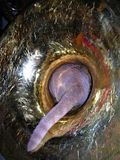I think this may have been asked before but the search is not giving good results so here goes.What is the advantage to a small shank lead pipe vs a large shank lead pipe. Seems like before cirrca 1930's many tubas had a small shank. Was this to make the horn more conical to produce a warmer tone?
Now the other question. Does putting on a large shank lead pipe affect intonation of a horn that originally had a small shank
tuba in question is a 1926 conn 2J eb.
Thanks
small shank vs large shank
- brassbow
- bugler

- Posts: 122
- Joined: Fri Dec 23, 2011 1:29 pm
- Donn
- 6 valves

- Posts: 5977
- Joined: Fri Aug 19, 2005 3:58 pm
- Location: Seattle, ☯
Re: small shank vs large shank
That said, you have to decide if you're willing to pay the price. For a playing difference that you may or may not actually be able to hear, on an acoustical basis that may not even apply to your instrument (you'd want to measure the interior bore at the end of the leadpipe), you probably get to forego the cost of swapping out the receiver - but you're stuck with a real limited selection of mouthpieces.
- Doug Elliott
- pro musician

- Posts: 611
- Joined: Wed Nov 12, 2008 8:59 pm
Re: small shank vs large shank
You should evaluate the intonation as it is first.
Putting on a larger receiver and/or leadpipe which will use larger shank mouthpieces with correspondingly larger backbores will make the entire instrument slightly less conical, which would tend to raise the pitch of the higher harmonics slightly while slightly brightening the sound. If that's what you want, or the instrument needs, go for it. I generally prefer to leave instruments they way they were designed unless there's a problem that's likely to be fixed by the change.
You don't want to make any undesireable pitch tendencies worse.
Putting on a larger receiver and/or leadpipe which will use larger shank mouthpieces with correspondingly larger backbores will make the entire instrument slightly less conical, which would tend to raise the pitch of the higher harmonics slightly while slightly brightening the sound. If that's what you want, or the instrument needs, go for it. I generally prefer to leave instruments they way they were designed unless there's a problem that's likely to be fixed by the change.
You don't want to make any undesireable pitch tendencies worse.
- brassbow
- bugler

- Posts: 122
- Joined: Fri Dec 23, 2011 1:29 pm
Re: small shank vs large shank
Ok got it. I will not change the leadpipe/shank size.
So as to original design, was the small bore/small shank use to make a more conical horn. Was the idea to make the horn's to warmer?
So as to original design, was the small bore/small shank use to make a more conical horn. Was the idea to make the horn's to warmer?
- Donn
- 6 valves

- Posts: 5977
- Joined: Fri Aug 19, 2005 3:58 pm
- Location: Seattle, ☯
Re: small shank vs large shank
I don't know for sure anyone knows the answer, but seems to me that to start with, the actual dimensions of your receiver and particularly the leadpipe, are necessary information. But since it's Tubenet and we don't need facts here, here are at least two obvious explanations for the existence of a small shank receiver: 1) it's acoustically superior for whatever reason, or 2) that's the way they came at the time. Do they come that way any more? Why? If this tuba is different from today's bass tubas and really benefits from the smaller receiver, then for sure it should also be using the mouthpiece of its time, right? What was that like, will bloke be offering one like it?
- Doug Elliott
- pro musician

- Posts: 611
- Joined: Wed Nov 12, 2008 8:59 pm
Re: small shank vs large shank
Consider the overall instrument design, not just the receiver. And the demands of the day vs. current demands. And that those were the early years of the instrument's evolution - tubas really hadn't been in existence very long.
I have always made those shank sizes for all of my mouthpieces.
I have always made those shank sizes for all of my mouthpieces.
